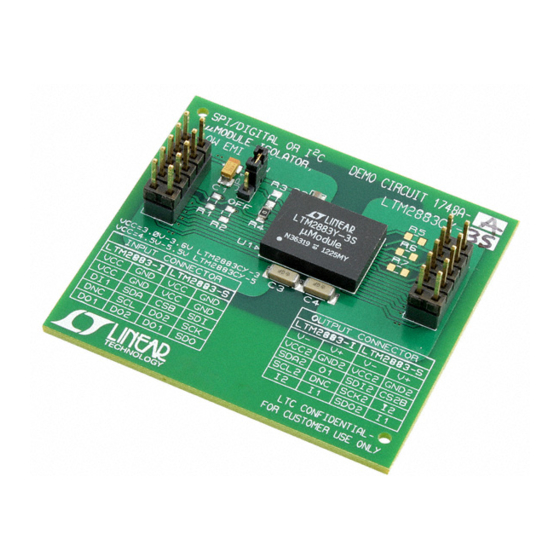
Advertisement
Description
Demonstration circuit 1749B is a 42V, 2.5A micropower
synchronous step-down regulator featuring the
The LT8610 is a compact, high efficiency, high speed
synchronous monolithic step-down switching regulator
that consumes only 2.5µA of quiescent current when
output is regulated at 5V. Top and bottom power switches,
compensation components and other necessary circuits
are inside of the LT8610 to minimize external components
and simplify design.
The SYNC pin on the demo board is grounded by default
for low ripple Burst Mode
an external clock, move JP1 to SYNC and apply the external
clock to the SYNC turret. Once JP1 is on SYNC position,
a DC voltage of higher than 2V or INTV
100
95
90
85
80
75
70
65
60
0
0.5
LOAD CURRENT (A)
Figure 1. LT8610 12V
Switching Frequency
42V, 2.5A Micropower Synchronous
LT
®
operation. To synchronous to
®
can be applied
CC
1
1.5
2
2.5
dc1749b F01
to 5V
Efficiency at 2MHz
IN
OUT
DEMO MANUAL DC1749B
Step-Down Regulator
to the SYNC turret for pulse-skipping operation. Figure 1
8610.
shows the efficiency of the circuit at 12V input.
The demo board has an EMI filter installed. The EMI per-
formance of the board is shown on Figure 2. The limit in
Figure 2 is EN55022 class B, average. It shows the circuit
passes the test with a wide margin.
The LT8610 data sheet gives a complete description of
the part, operation and application information. The data
sheet must be read in conjunction with this quick start
guide for demo circuit 1749B.
Design files for this circuit board are available at
http://www.linear.com/demo/DC1749B
L, LT, LTC, LTM, Linear Technology, Burst Mode and the Linear logo are registered trademarks
of Linear Technology Corporation. All other trademarks are the property of their respective
owners.
10 dB/DIV
80
70
60
50
40
30
20
10
0
–10
START 150kHz
RES BW (CISPR) 9kHz
Figure 2. LT8610 Demo Circuit EMI Performance,
Switching Frequency = 2MHz
LT8610
MKR1 2.003MHz
21.69 dBµV
VBW 62kHz
STOP 30MHz
SWEEP 717ms (6637 PTS)
dc1749b F02
dc1749bfa
1
Advertisement
Table of Contents

Summary of Contents for Linear Technology DC1749B
- Page 1 DC voltage of higher than 2V or INTV can be applied L, LT, LTC, LTM, Linear Technology, Burst Mode and the Linear logo are registered trademarks of Linear Technology Corporation. All other trademarks are the property of their respective owners.
-
Page 2: Performance Summary
DEMO MANUAL DC1749B performance summary Specifications are at T = 25°C SYMBOL PARAMETER CONDITIONS UNITS Input Supply Range Output Voltage Maximum Output Current Switching Frequency 1.85 2.15 Efficiency at DC = 1A Quick start proceDure Demonstration circuit 1749B is easy to set up to evalu- 2. - Page 3 DEMO MANUAL DC1749B Quick start proceDure DC1749b F04 Figure 4. Measure Output Ripple dc1749bfa...
-
Page 4: Parts List
DEMO MANUAL DC1749B parts List ITEM REFERENCE PART DESCRIPTION MANUFACTURER/PART NUMBER Required Circuit Components CAP, X7R, 4.7µF, 50V, 10%, 1206 MURATA, GRM31CR71H475KA12L CAP, X7R, 0.22µF, 16V, 10%, 0603 AVX, 0603YC224KAT2A CAP, C0G, 10pF, 25V, 10%, 0402 AVX, 04023A100KAT2A CAP, X7R, 47µF, 10V, 10%, 1210 MURATA, GRM32ER71A476KE20L CAP, X7R, 1µF, 25V, 10%, 0603... -
Page 5: Schematic Diagram
Information furnished by Linear Technology Corporation is believed to be accurate and reliable. However, no responsibility is assumed for its use. Linear Technology Corporation makes no representa- tion that the interconnection of its circuits as described herein will not infringe on existing patent rights. - Page 6 Linear Technology Corporation (LTC) provides the enclosed product(s) under the following AS IS conditions: This demonstration board (DEMO BOARD) kit being sold or provided by Linear Technology is intended for use for ENGINEERING DEVELOPMENT OR EVALUATION PURPOSES ONLY and is not provided by LTC for commercial use. As such, the DEMO BOARD herein may not be complete in terms of required design-, marketing-, and/or manufacturing-related protective considerations, including but not limited to product safety measures typically found in finished commercial goods.












Need help?
Do you have a question about the DC1749B and is the answer not in the manual?
Questions and answers